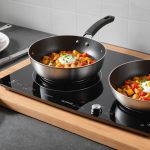Overview of Induction Cooktops
Induction cooktops have revolutionized the modern kitchen by offering a cutting-edge cooking technology that differs from traditional gas and electric methods. Unlike conventional stoves, induction cooktops use electromagnetic fields to generate heat directly in the cookware, resulting in a faster and more efficient cooking process. When a compatible pot is placed on the cooktop, the electromagnetic waves excite the metal, generating heat rapidly.
The benefits of induction cooking are numerous: precision in temperature control, energy efficiency, and enhanced safety since the cooktop remains cool to the touch. Comparatively, gas cooktops require combustion to produce heat, while electric stoves use a heated element, both methods leading to ambient heat waste and longer cook times.
Have you seen this : Enhance food safety and nutritional value in your kitchen with uv light sanitizers
The development of this technology traces back to early 20th-century experiments, but it was not until the late 1970s that induction cooktops became commercially viable. As technology has advanced, so has the popularity of these cooktops, driven by their modern appeal and practical advantages over traditional cooking methods. Today, induction cooking stands out as a testament to the evolution of kitchen appliances toward more sustainable and efficient solutions.
Energy Efficiency of Induction Cooktops
Induction cooktops are at the forefront of energy-efficient cooking, marking a significant shift from traditional methods. Unlike electric and gas cooktops, induction technology employs electromagnetic fields to heat cookware directly. This results in minimal heat loss and contributes significantly to induction cooking energy savings.
Have you seen this : Elevate your kitchen”s air quality: discover the health advantages of uv-c air purifiers for eliminating harmful contaminants
Using induction cooktops is known to save approximately 10-20% more energy compared to conventional electric cooktops. Additionally, induction cooktops transfer 84% of the energy produced directly to food, opposed to the 74% efficiency of traditional electric and 40% of gas. Statistics reveal that such efficiency can lead to a 50% reduction in cooking-related carbon emissions, promoting eco-friendly cooking solutions.
The quicker heating element of induction cooktops means not only faster meal preparation but also reduced time—hence energy—usage. This rapid response can reduce overall cooking times by up to 25%, substantially contributing to energy efficiency. Embracing induction cooking is a practical step towards lowering household energy consumption and supporting environmentally friendly living. Such advancements in cooking technology underscore both cost-saving and a commitment to sustainable cooking practices.
Health Benefits of Cooking with Induction
Cooking with induction hobs offers multiple healthier cooking methods due to advanced technology. One of the most significant benefits is the reduced risk of burns and accidental fires. Unlike gas cooktops, induction cookers heat pans directly without an open flame, drastically lowering the likelihood of burns and making the kitchen environment safer.
Additionally, induction technology minimises heat radiation, creating a safer space where overheating is unlikely to occur. The surrounding areas remain cool, reducing risks related to excessive heat exposure. This safety feature also means induction cooktops are less likely to cause accidental fires, a common concern with traditional gas appliances.
Moreover, the precision of cooking temperature control on an induction cooktop is unmatched. This allows for meticulous temperature adjustments that lead to healthier cooking practices. Overcooking or burning food can produce harmful compounds, but with precise control, these risks are mitigated, ensuring meals are prepared optimally.
Understanding these benefits, one can see how induction cooking supports safer and healthier cooking environments while offering control and precision not found in other cooking methods.
User-Friendly Features of Induction Cooktops
Induction cooktops are celebrated for their user-friendly features, which make cooking not only easier but also safer. One of the standout attributes is their intuitive controls. Many models are equipped with touch-sensitive panels that are straightforward, offering precise temperature adjustments with a simple tap or swipe. This design ensures that even those new to induction cooking can operate them with ease.
In terms of safety, induction cooktops present innovative features such as the auto shut-off mechanism. This function automatically turns off the cooktop when it detects overheating or if a pot has boiled dry, significantly reducing the risk of accidents in the kitchen.
The ease of cleaning is another significant advantage. Induction cooktops have a sleek, smooth surface that prevents spills and splatters from sticking. Simply wiping them down with a damp cloth after use can keep them looking pristine.
Furthermore, many modern induction cooktops incorporate smart cooking technologies. These include Wi-Fi and app connectivity, allowing users to monitor and adjust their cooktop remotely. Such technology not only enhances cooking convenience but also aligns with contemporary lifestyles, making meal preparation both efficient and enjoyable.
Selecting the Right Induction Cooktop
Choosing the ideal induction cooktop can be a straightforward process when focusing on essential features. Start with the size—ensure the cooktop matches your kitchen space and cooking needs. Some models cater to compact spaces, while others boast multiple zones for simultaneous cooking. Assess the power settings next. Different models offer varied wattage, which influences cooking speed and efficiency. A versatile range of power settings is vital for flexibility.
Before making a purchase, consult an induction cooktop buying guide to gauge price ranges suitable for your budget. It’s critical to check cookware compatibility. Induction relies on magnetic fields, so your pots and pans must contain ferrous metals. Use a magnet to test compatibility if unsure.
Turn to trusted brands when selecting a model. Reputable brands offer durability and robust warranties, ensuring peace of mind. Exploring models like Bosch, GE, or Samsung can provide a satisfying balance of quality and innovation. By evaluating these factors and following a comprehensive guide, you’ll secure the best cooktop tailored to your culinary style.
Practical Examples and User Testimonials
Switching to an induction cooktop has transformed the cooking experience for many. One such case involved a family of four, who previously relied on traditional gas stoves. After transitioning, they reported significant improvements in meal preparation speed and efficiency. Real-life cooking experiences often highlight how induction cooktops reduce cooking times, allowing busy individuals to prepare meals faster while maintaining food quality.
Users consistently praise the enhanced cooking performance of induction cooktops. One user noted the precise temperature control it provides, allowing them to cook delicate sauces without the risk of burning. Feedback indicates that induction cooking not only conserves energy but also elevates the overall culinary experience by offering consistent and reliable heat.
Studies comparing user satisfaction between traditional and induction methods overwhelmingly show a preference for induction. Visual aids such as charts reveal how induction cooktops score higher on satisfaction metrics, particularly for ease of cleaning and energy efficiency. These testimonies demonstrate that once individuals experience the convenience and performance of induction cooking, they seldom consider returning to old methods. The positive user reviews are clear indicators of the remarkable transformation in everyday cooking routines.











